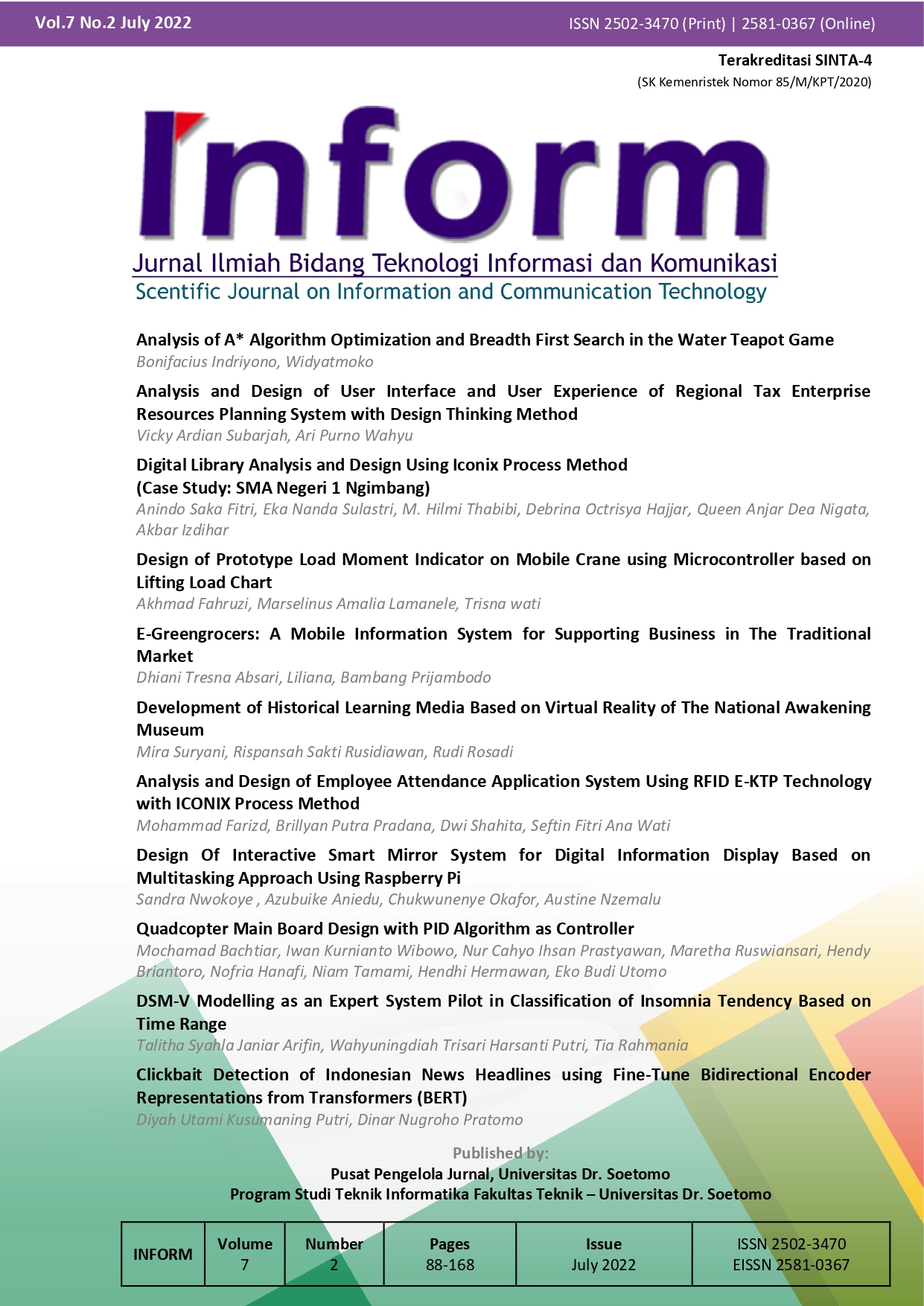E-Greengrocers: A Mobile Information System for Supporting Business in The Traditional Market
 Abstract views: 223
,
Abstract views: 223
,
 PDF downloads: 236
PDF downloads: 236
Abstract
The covid-19 pandemic has affected many sides of human life. World Health Organization (WHO) and health sectors worldwide have suggested physical distancing to battle the pandemic. The physical distancing is causing many adjustments in the business implementations. For rural developing countries, grocery shopping at itinerant greengrocers may increase the risks of infection because there are direct interactions between the seller and the buyer and the habit of shopping in a crowd without concerning the physical distancing protocol. E-Greengrocers application is proposed as the innovative approach to help the traditional market support their activities with fewer contact interactions. The application is projected to facilitate a safe transaction between greengrocers and their buyers. This research was developed using the waterfall methodology and descriptive case study. Observations and the distribution of questionnaires among the itinerant greengrocers and buyers are used as a tool to obtain the necessary data. The questionnaire result shows that all users were satisfied with the features provided. More than 61% of users perceived it helpful, and 30% found it very helpful. The features facilitated minimum contact on transactions and maintained sustainable income from the itinerant's greengrocers’ point of view.
References
X. Zhang, Z. Ji, Y. Yue, H. Liu, and J. Wang, "Infection Risk Assessment of COVID-19 through Aerosol Transmission: A Case Study of South China Seafood Market," Environ. Sci. Technol., vol. 55, no. 7, pp. 4123–4133, 2021.
D. Nudiati and E. Sulistiono, "Implementation of Protective Measures to Prevent Covid-19 Transmission in Traditional Markets," Proc. First Transnatl. Webinar Adult Contin. Educ. (TRACED 2020), vol. 548, no. Traced 2020, pp. 1–5, 2021.
Q. Xu and M. Chraibi, "On the effectiveness of the measures in supermarkets for reducing contact among customers during COVID-19 period," Sustain., vol. 12, no. 22, pp. 1–14, 2020.
A. V. Vitianingsih, Z. Othman, S. Suhana, and K. Baharin, "Spatial Analysis for the Classification of Prone Roads Traffic Accidents: A Systematic Literature Review," Int. J. Adv. Trends Comput. Sci. Eng., vol. 10, no. 2, pp. 583–599, 2021.
A. V. Vitianingsih, N. Suryana, and Z. Othman, "Spatial analysis model for traffic accident-prone roads classification: A proposed framework," IAES Int. J. Artif. Intell., vol. 10, no. 2, pp. 365–373, 2021.
A. V. Vitianingsih, S. S. K. Baharin, O. Othman, and A. Suraji, "Empirical Study of a Spatial Analysis for Prone Road Traffic Accident Classification based on MCDM Method," Int. J. Adv. Comput. Sci. Appl., vol. 13, no. 5, pp. 665–679, 2022.
S. Steiniger, M. Neun, and A. Edwardes, "Foundations of Location Based Services Lesson 1 CartouCHe 1- Lecture Notes on LBS, V. 1.0," 2011.
H.-H. Lee, I.-K. Park, and K.-S. Hong, "Design and Implementation of a Mobile Devices-Based Real-Time Location Tracking," in International Conference on Mobile Ubiquitous Computing, Systems, Services and Technologies (UBICOMM), 2018.
V. C. S. Yeo, S. K. Goh, and S. Rezaei, "Consumer experiences, attitude and behavioral intention toward online food delivery (OFD) services," J. Retail. Consum. Serv., vol. 35, no. July 2016, pp. 150–162, 2017.
S. S. Soliman and C. E. Wheatley, "Geolocation technologies and applications for third generation wireless," Wirel. Commun. Mob. Comput., vol. 2, no. 3, pp. 229–251, 2002.
B. Reformat, "The increased importance of geo-location in retail trade in Poland – selected aspects of activities," Ann. Univ. Mariae Curie-Skłodowska, Sect. H – Oeconomia, vol. 53, no. 2, p. 67, 2019.
J. Benson, "LBS technology delivers information where and when its needed," Bus. Geogr., vol. 9, no. 2, pp. 20–22, 2001.
M. H. MZ, “Aplikasi Rekomendasi Spot Area Wisata Berbasis Android dengan Teknik Geotag,†Inf. J. Ilm. Bid. Teknol. Inf. dan Komun., vol. 2, no. 2, pp. 6–11, 2017.
Axel Küpper, Location-based services: fundamentals and operation. 2005.
D. Ruzic, A. Bilos, and I. Kelic, "Development of Mobile Marketing in Croatian Tourism Using Location-Based Services," Tour. Hosp. Manag., no. December 2006, pp. 151–159, 2012.
P. Oleksiak, “Business applications of geolocation - modern solutions and trends,†W Inform. 2 przyszłości 30 Lat Inform. Na Wydz. Zarządzania UW, pp. 52–61, 2015.
Siti Noor Syalwani Mustapa, A. Anuar, and Z. M. Piah, "Food Delivery Business: A New Trend in 2020," FBM Insights, vol. 3, p. 13, 2021.
A. Alshamrani and A. Bahattab, "A Comparison Between Three SDLC Models Waterfall Model, Spiral Model, and Incremental/Iterative Model," IJCSI Int. J. Comput. Sci. Issues, vol. 12, no. 1, pp. 106–111, 2015.
P. Dybka, "Crow's Foot Notation," Vertabelo SA, 2020. .
J. Recker, "BPMN Modeling - Who, Where, How and Why," BPTrends, 2008.
A. Subiakto, D. T. Absari, and L. Liliana, “Pembuatan Aplikasi E-Tukang Sayur Berbasis Android,†2019.
Copyright (c) 2022 Dhiani Tresna Absari, Liliana

This work is licensed under a Creative Commons Attribution-ShareAlike 4.0 International License.
Authors who publish with Inform: Jurnal Ilmiah Bidang Teknologi Informasi dan Komunikasi agree to the following terms:
-
Authors retain copyright and grant the journal right of first publication with the work simultaneously licensed under a Creative Commons Attribution License (CC BY-SA 4.0) that allows others to share the work with an acknowledgment of the work's authorship and initial publication in this journal.
-
Authors are able to enter into separate, additional contractual arrangements for the non-exclusive distribution of the journal's published version of the work (e.g., post it to an institutional repository or publish it in a book), with an acknowledgment of its initial publication in this journal.
-
Authors are permitted and encouraged to post their work online (e.g., in institutional repositories or on their website) prior to and during the submission process, as it can lead to productive exchanges, as well as earlier and greater citation of published work.













